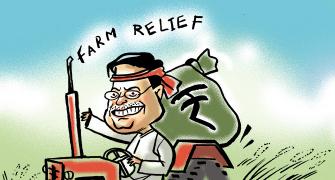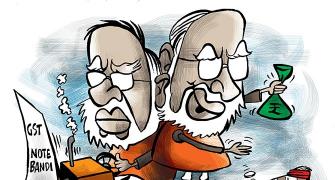GST rate cut for real-estate, income transfer scheme, farm loan waivers execution and recapitalisation of PSU banks have the potential to boost India’s growth in a few months, says Neelkanth Mishra.
Illustration: Uttam Ghosh/Rediff.com

Debatable as the analytical utility of quarterly GDP statistics in India may be, the continuing drop in growth rates as recently reported for the December quarter surprised no one: If anything the magnitude of the drop was larger than expected.
Over the last several months, economic momentum has steadily worsened, as measured by the growth of monthly sales of largely formal sectors.
Even the decline in prices of crude oil did not provide the relief that was expected by many.
Growth in the current quarter is projected to slow further.
Is this the new normal?
Far from it; there are too many positive structural changes that the Indian economy is undergoing for its potential growth rate to fall so steeply.
But then, what can revive growth?
It is clear that the slowdown has been consumption-driven.
Investments, on other hand, as measured by Gross Fixed Capital Formation (GFCF), continued to grow in double-digits for the fifth quarter in a row, and the ratio of GFCF to GDP continued to inch up, though, to be sure, there is no euphoria yet.
The two primary drivers of slowing consumption are weak food prices stalling income transfers from the rich to the poor, and the end of the Pay Commission cycle.
It is worth repeating that we have gone through the Seventh Pay Commission implementation in the last three years without the aggregate deficit blowing up.
In contrast, during the last two pay commissions (there is one every decade), the fiscal deficit rose sharply, as the pension and salary expenditures of governments rose by 2 to 2.5 per cent of GDP.
Observers wringing their hands at fiscal deficits in India being unchanged for five years also forget that these are still among the lowest in India’s history (absolute deficits are no doubt among the highest in the world: State plus central government deficits add up to more than 6 per cent of GDP).
As a share of financial savings, the ratio has fallen, implying less crowding out.
Further, with the salary bill now rising at a pace slower than nominal GDP, more than 1 per cent of GDP of fiscal space could open up in the next three years.
Yet the bond market has continued to punish the government with bond yields that are higher than they need to be.
The term premium, which is the difference between the repo rate set by the RBI and the yield on the 10-year government bond, is elevated compared to its history.
Many observers think the market is efficient, and that elevated yields are just the markets disciplining the government.
That may indeed be a factor, but one must not forget that markets often misprice assets, and that the Indian bond market is far from liquid: Nearly half the bond buying is conducted by treasury departments of banks that are often passive.
That is perhaps one reason why technical charts are used to price bonds.
By terming the government bond as just another security whose price they do not seek to control, policymakers have under-estimated the critical role their yields play in the pricing of debt in the economy.
This high term premium is on top of very high real interest rates, due to the Monetary Policy Committee (MPC) missing an inflection point in agricultural surpluses, and persistently overestimating inflation.
While moving from an era where the RBI governor set the rates using a touchy-feely approach to a much more quantitative committee-based approach is progress, this move was made without any improvement in the inflation and growth forecasting capability of the MPC.
Observers have pointed to the problem of every member relying on only one set of inflation projections -- if these are wrong the economy suffers, as it has done for many quarters.
Recent MPC commentary points to improvements being brought about in the inflation forecasting process - another sign of improving systemic maturity.
Even though the MPC has in the last two meetings brought down its inflation projections substantially, inflation is still below its forecasts.
Now, the MPC’s growth projection for the coming year of 7.2 to 7.4 per cent also seems too high, as the Central Statistics Office (CSO) projects just 6.3 per cent growth in the current quarter.
Can growth accelerate a full per cent point without a meaningful catalyst?
Would the MPC cutting rates make a difference?
The Indian economy is not known to be particularly rate sensitive, but in the current environment it might just be.
If the short end of the rate curve (that is, the repo rate) is pushed down, either the term premium expands further, which would be hard to justify, or the 10-year government bond yields would fall.
This may in fact provide some relief to the beleaguered bond mutual funds struggling with outflows, as well as the funding availability for non-banking finance companies (NBFCs).
The most important takeaway for us from the December quarter results reported by companies was the sharp slowdown in NBFC credit disbursement.
Banking system credit data is made available every fortnight but even though non-banking sources of finance have become much more important in recent years than they have ever been, there is no systemic credit measure that is reported frequently.
Quarterly results were therefore the first available indicator of the extent of the slowdown in aggregate credit.
Anecdotally this has become worse in the current quarter: Lower yields would at least prevent further deterioration even if they do not quickly bring back growth.
There are four fiscal boosts as well that will become effective in a few months: The GST rate cut for real-estate may help break the buyers’ strike and restart cash flows in real estate.
The income transfer scheme is of a meaningful size, but it might need to be recalibrated (the frequency and size of transfers, as well as the number of beneficiaries) for greater economic impact.
Thirdly, if farm loan waivers get executed in time, and banks restart agricultural credit disbursement (they hold back while loan waivers are being implemented), it could support cash flows in the agricultural economy.
And lastly, the recapitalisation of PSU banks adds some capacity to the financial system.
Without the financial system breaking out of its current stasis however, these measures may not be sufficient to push India back to its potential growth rate again.
Neelkanth Mishra is co-head of Asia Pacific Strategy and India Strategist for Credit Suisse.










